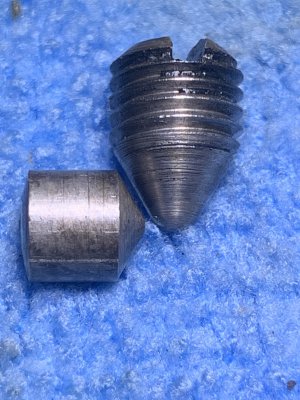Hello all. I thought I would chime in on this subject as I own 2 South Bend 9" lathes and I am familiar with this part.
First, the pin (shoe) on the side of the cross slide (CS) nut does indeed "lock" the nut to the side of the mounting hole. And
by "lock" I mean it applies pressure to the nut to take up any play or movement that would show up as increased backlash.
This shoe is forced out laterally by the top screw, a very small 5/16-24 screw with a 45-degree angle on the bottom. Screwing
down on it forces it to push the shoe outward (the shoe itself has a 45-degree angle. (I will attempt to provide a photo).
These pins are very small and difficult to come by, tho they may show up occasionally on Ebay. A problem that develops is that after
decades of swarf and zero lubrication, the threads on this screw as well as the shoe itself can become quite stuck, resulting in a buggered
up screw slot. So much so that it may be impossible to remove. (I do wish that SB had used an Allen head instead of a straight slot).
I HIGHLY recommend that you replace your cross-slide nuts immediately if you have not done so yet, both on the cross-slide and on the upper compound rest. Backlash will be reduced to a very great extent. But the absolute minimum amount of backlash will only be achieved by replacing both the nuts AND the ACME thread. (a word about that below).
In regards to a nut made of Delrin, I think that yes that is possible, but being plastic, you will not get as much "mileage" out of it as opposed to brass or bronze. I love the machinability of Delrin, but in this case, I don't think the wear factor is a good one. The brass replacement nuts aren't very expensive, so there's really no reason to machine one out of Delrin. If they were a good option, Ebay would be full of them for people to use.
There is a lot more info you need to know about these cross-slide nuts. To help make this post a lot shorter, allow me to recommend a thread I started over on Practical Machinist entitled "9" Cross Feed Nut Replacement". (I cannot post a link here apparently)
There is also something that you can help me with. I have discovered that there is NO hole at the bottom of the vertical shaft that goes into the internal ACME threads on the nut, either on the original nuts made and fitted by S Bend, nor on the new reproductions. Without a small hole, the screw threads get absolutely NO lubrication causing significant premature wear to the mating threads! The way it SHOULD work is that during the course of regular lubrication of your machine, you should unscrew the slotted screw; fill the cavity with oil; work the handle crank to spread and distribute the oil over the entire CS thread (may take more oil as you do this); then re-install the top screw, Be careful not to bear down to the point of buggering the slot!
Where you can help: If you own a SB 9" or 10" lathe (light), and if you have the original nuts in there, I need to know if you have an oil hole that extends into the threads or not. Assuming you can back off the screw, you can test this either by filling the column with oil to see if it drains, or, by inserting a small wire to feel if there is a hole present. I have two original SB nuts and neither of them are drilled! I would like to know if there are more out there like this! This info would be very helpful!!
One last parting word of advice. To the best of my knowledge, there is no way to adequately oil the CS screw without removing the top compound rest assembly...what a pain! The only other way is shooting oil up from the bottom, through the bed "webs" up into a small hole in the casting! It's not supposed to be this hard guys!! So, if/when you do replace the cross-slide nut, be absolutely sure you drill a small 1/8th" hole that extends down into the threads...the repros are not drilled. This is save your CS mechanism from future pre-mature wear.
Again, please thoroughly read the thread at the link above for some tips. (When replacing the nut with a repro, be certain to deburr the hole for the shoe...it must slide freely!)
View attachment 351719View attachment 351726
Regards,
PMc

